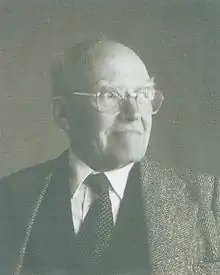Eladio Dieste
Eladio Dieste (December 1, 1917 – July 29, 2000) was a Uruguayan engineer who made his reputation by building a range of structures from grain silos, factory sheds, markets and churches, most of them in Uruguay and all of exceptional elegance.
Eladio Dieste | |
|---|---|
 | |
| Born | 1 December 1917 |
| Died | 20 July 2000 (aged 82) |
| Nationality | Uruguayan |
| Occupation | Architect |

Biography
Dieste was born in Artigas department. His uncle was the Spanish poet Rafael Dieste.
A particular innovation was his Gaussian vault, a thin-shell structure for roofs in single-thickness brick, that derives its stiffness and strength from a double curvature catenary arch form that resists buckling failure.[1]
There were several architects and engineers in South and Latin America who were working in the modernist language, such as Guillermo Gonzalez Zuleta in Colombia, Carlos Raúl Villanueva in Venezuela and Félix Candela in Mexico, who brought architecture and structural engineering into close proximity, especially when undertaking humble commissions. His buildings were mostly roofed with thin shell vaults constructed of brick and ceramic tiles. These forms were cheaper than reinforced concrete, and didn't require ribs and beams. In developing this approach, even in comparison with modernists the world over, he was an innovator.[2]
Dieste is quoted about his use of materials and structure:
- There are deep moral/practical reasons for our search which give form to our work: with the form we create we can adjust to the laws of matter with all reverence, forming a dialogue with reality and its mysteries in essential communion... For architecture to be truly constructed, the materials must be used with profound respect for their essence and possibilities; only thus can 'cosmic economy' be achieved... in agreement with the profound order of the world; only then can have that authority that so astounds us in the great works of the past.[3]
With regard to structure Dieste stated:
- The resistant virtues of the structure that we make depend on their form; it is through their form that they are stable and not because of an awkward accumulation of materials. There is nothing more noble and elegant from an intellectual viewpoint than this; resistance through form.[4]
Many of the techniques that he developed to achieve these forms, such as pre-stressing of brickwork and moveable formworks, were in advance of contemporary techniques in the developed world.
He died, aged 82, in Montevideo.
Selected works
- St. Peter Church in Durazno
- Christ the Worker Church in Estación Atlántida[5]
- Church of Our Lady of Lourdes in Malvín
- St. John of Avila Church in Alcalá de Henares
- Teatro de Verano Ramón Collazo in Montevideo
- Montevideo Shopping (structure of the first stage, 1985; architect: Guillermo Gómez Platero)
- Church of St. Charles Borromeo (structural calculation, 1956; architect: Juan Pablo Terra)
References
- The double-curvature masonry vaults of Eladio Dieste, Pedreschi, R, Theodossopoulos, D, ICE Proceedings, Structures and Buildings, Vol 160, Issue 1, pp 3-11, Thomas Telford – ICE Virtual Library
- Anderson, Stanford. Eladio Dieste: Innovation in Structural Art, (New York: Princeton Architectural Press, 2004).
- Quoted from Modern Architecture since 1900, p575.
- Quoted from Eladio Dieste – The Engineer's Contribution to Contemporary Architecture, page 21.
- Porley, Carolina (28 April 2017). "The other creators". Brecha. (in Spanish)
Sources
- Anderson, Stanford, ed. (2004). Eladio Dieste : innovation in structural art. Princeton Architectural Press. ISBN 1-56898-371-9. |
- Curtis, William (2002). Modern Architecture since 1900. Phaidon. ISBN 0-7148-3356-8.
- Pedreschi, Remo (2000). Eladio Dieste – The Engineer's Contribution to Contemporary Architecture. Thomas Telford. ISBN 0-7277-2772-9.
- Fausto Giovannardi "Eladio Dieste: un'ingegneria magica", Fausto Giovannardi. Borgo San Lorenzo, 2007.
